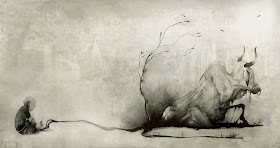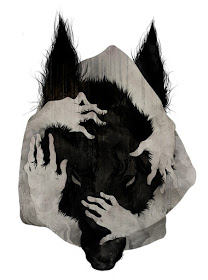Maria Tatar put up a link on her blog yesterday to an LA Times article discussing the too dark/not-dark-enough movie The Hunger Games.
Having just read the books this past month I finally have some sense of why they are so popular, though any talk of "teams" or fan-squee-ing has me scratching my head since they're just not those sorts of books. It's taken me a long while to get on board (since having wasted time and money on previously highly popular YA books) but I can gladly say these are well written and well worth the investment. I wouldn't be surprised if they became required reading for high school at some point.
 Note: If you managed to avoid all sense of the books as I did before reading, for the purposes of this post you should know (don't worry - this is premise - no spoilers) that it's set in a near post-war (aka post apocalyptic) future in which people are divided into districts and controlled by a wealthy Capitol. In order to keep the districts under control each year the districts are forced to send two children, aged between 12 and 18, to "The Hunger Games", to fight each other to the death - while everyone watches (viewing is mandatory) via an exploitive media and "entertainment-fest". The heroine, Katniss Everdeen, steps up to take the place of her younger sister during the reaping/choosing.
Note: If you managed to avoid all sense of the books as I did before reading, for the purposes of this post you should know (don't worry - this is premise - no spoilers) that it's set in a near post-war (aka post apocalyptic) future in which people are divided into districts and controlled by a wealthy Capitol. In order to keep the districts under control each year the districts are forced to send two children, aged between 12 and 18, to "The Hunger Games", to fight each other to the death - while everyone watches (viewing is mandatory) via an exploitive media and "entertainment-fest". The heroine, Katniss Everdeen, steps up to take the place of her younger sister during the reaping/choosing.
I have since been very concerned that any movie will not do justice to the book, the characters, the story or the issues in the series and sadly foresee many people not even bothering to pick up the books after dismissing the sensationalized (by the media and of the issues) movie. Despite that the story is riveting and there is plenty of fodder that
should make for an amazing film, I think the subject matter (think
Lord of the Flies +
1984 +
Gladiators and more),
juggled with trying to keep it accessible to an under-18 audience, is a task beyond most filmmakers today. (You may have heard about the removal of 7 seconds of blood spatter to allow the film a PG rating. The result is that the direness of Katniss' situation is severely diluted from an audience perspective - exactly what the books aim NOT to do, though Ms. Collins manages to keep the peril very present without concentration on the gore, thanks to excellent writing.) From the reviews, it's suffering from just that problem, even having the author on board as writer ad consultant for the script. It's a weird feeling: wishing the film would do very well and simultaneously wishing it would pass quickly by so the books would retain their popularity and intrigue, causing more people to read them. If you at all interested in seeing the movie, please pick up the book first and give it a read before you do. It's a very quick read and you won't be sorry.
That said, I was very interested to read how the author, Suzanne Collins, was inspired by the myth of
Theseus and the Minotaur in particular. As a result, it's not to much of a stretch to find parallels in fairy tales either.
Here are a couple of excerpts from the article:
Collins has said she found inspiration for her story, which is set in the future, in the ancient Greek myth of Theseus and the Minotaur, in which the Cypriots demand Athens send seven boys and girls each year as food for the half-man, half-bull, until Theseus slays the beast. In "The Hunger Games," Katniss Everdeen, a 16-year-old tomboy handy with a bow and arrow, is a Theseus-type character, a young savior fighting on behalf of all the other children.
...The brutality of "The Hunger Games," which results in the deaths of more than 20 youths, follows in the gory footsteps of many of the Grimms' fairy tales, which were first published in 1812. In "Hansel and Gretel," a pair of abandoned siblings escape from a cannibalistic witch by stuffing her into the oven; in "The Juniper Tree," a woman slams the lid of a trunk on her stepson and decapitates him; and in the axiomatically titled "How Some Children Play at Slaughtering," a little boy stands in for a pig in a child's game of butchering.
I highly recommend reading all Ms. Tatar's comments (she is quote in the article) on why we are so compelled by this subject and why Katniss is such an appealing heroine for both adults and children. You can read the whole article
HERE.
While at first glance
The Hunger Games doesn't appear to have much in common with fairy tales at all it isn't hard to think of connections once you start. I'm reminded of stories about Koschei the Deathless, to the Little Match Girl to Deals with the Devil to tales in which girls, all striving to appear perfect as suitors to a prince fail in their conformity and lose their heads. (It's the girl who breaks most of the rules that gets chosen in the end, though why she would want to marry someone who would have cut off her head a few minutes before is disturbing. I'm guessing, like the Miller's Daughter, you will do things you never would have considered to save not just your life but the lives of those you love.) I wish I could remember which tale this last one was! I think it had an Asian origin, although there are a few Russian ones that have similar tropes as well, not to mention Scheherezade's predicament, though she wasn't having to kill other women at the same time.

The story of the Hunger Games is told mainly through the heroine, Katniss' eyes so the stakes are very immediate and real for the reader. Fairy tales are often set in a nebulous time and are somewhat removed from us via the matter-of-fact story telling so that one tends to adjust to the story, implications and messages in it as one is emotionally and mentally ready. Not so
The Hunger Games. Although the story of death, slaughter, risk and sacrifice isn't a new idea, as fairy tales from many cultures attest to, having the setting and characters be so specific in their voice and set in a time we can see as a possibility in our own futures, brings home the chill of how little mankind has changed since our gruesome, gory and bloody (recent) past. But will it be the wake-up call, the Prometheus, if you will, that society needs? Sadly, our own media machines and the tendency to rev up fandom as a response to extreme ideas results in diluting the very issues that caught out attention in the first place (we already have parodies of the books widely available and Hunger Games cookbooks and badges for "teams". Even the Twitter feed of Lions Gate Films announcing the cast is almost an exact echo of the how the children chosen for slaughter are "introduced" to the public... *shudder*). The very fact that we have a movie - and marketing - like this may just be a dark mirror of its source (though many won't even realize it).

It's a reminder (to me) that we should be familiar with our fairy tales and holding their lessons close. History has a tendency to repeat itself and we can't say we haven't been warned.
At the time of this writing
The Hunger Games books are available at a discounted price almost everywhere (pharmacies, Targets, Kmarts and Walmarts etc), with the first book in paperback being available for around the $6 mark (except in bookstores like Barnes & Noble, though Amazon's price is currently low too). Online you can get the first book, which the movie is based on,
HERE.























.jpeg)



.jpg)




























